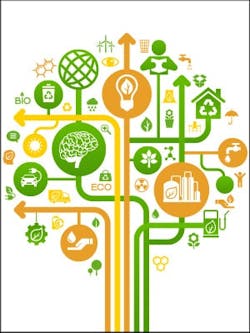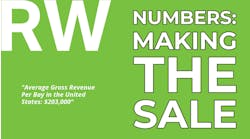Mike Margulis has always been associated with one word.
“My first grade teacher always used to call me ‘thrifty,’” he recalls. “‘He wants to turn the paper over and use the other side,’ she would say. I was born that way.”
As a person who cares deeply about the environment and his effect on it, being eco-friendly has always been second nature. But as a businessman looking to cut costs and improve operations? For Margulis, owner of E&B Auto Repair in Fort Bragg, Calif., energy efficiency become a necessity.
Steven Schillinger, a consultant for the NAPA GreenCare program and Governmental Regulatory Compliance LLC, a Pirk Management Company, works with mechanical shops and says your business’s carbon footprint shouldn’t be an afterthought. With governmental regulations pressuring utility companies to lower energy usage, following suit in your own shop is not only becoming more and more affordable, but also saves money in the long run by lowering energy bills each month.
Two shop owners—Margulis and Kevin Donohoe of Pacific Motor Service in Monterey, Calif.—list the equipment most crucial to improving energy efficiency in their businesses.
Before You Buy: Know How to Track the ROI
You can’t just buy equipment you’ve heard is “energy efficient” and place it in your shop, Schillinger says. Depending on your carbon footprint and car count, some investments are worth more than others.
“You need to do an official, professional engineering evaluation based on what your energy usage is right now,” he says.
“Unfortunately, it’s not immediately evident or aware to small business owners because of the conversions you have to do.”
Schillinger references four key components of energy in the average shop: electricity, gas, water and waste. Electricity typically makes up 60 percent of your carbon footprint, while the other factors range in percentage from shop to shop, he says.
Taking your old energy bills, which are generally available electronically, Schillinger says to do an assessment of your energy consumption timeline and compare those costs with new equipment and fluctuations in labor hours and car count.
“If you’ve increased by two employees and your car count has gone up, obviously you’re going to use more energy,” he says. “But in reality, it may have been reduced because of the small measures you’ve taken.”
Schillinger says while many are discouraged by how long it can take to see a return on energy efficient equipment, tracking the tiniest of savings—even the pennies—can help view that investment long term.
Fluorescent Light Fixtures
Benefits: Schillinger says since lighting makes up 50 percent of your electricity usage, making upgrades to your lighting system a must.
Savings for installing LED light fixtures will depend entirely on the kilowatt hours (kWh) conversion. If you switch from 100 kWh to 50 kWh, you’ll be using half the amount of electricity, Schillinger says.
ROI: Both Margulis and Donohoe upgraded to energy efficient fluorescent fixtures in the last 10 years and have seen or expect to see a return. Donohoe, for example, spent $8,000 to re-outfit his two shops, and saw a return within four years. Margulis expects to see a return within six to eight years.
According to data from the Institute of the Environment and Sustainability at the University of California, Los Angeles, the average cost per square foot for an LED upgrade to a business is around $5 (depending on how much you upgrade), and the average business sees a 45 percent return within two years. Schillinger says there are numerous online tools, such as LED saving calculators, that help determine your ROI timeline.
An Energy Efficiency Checklist
Schillinger provides this checklist (PDF) to businesses looking to become more energy efficient.
LED lighting also requires less maintenance. The lifespan of LEDs is approximately 50,000 hours when operated 24 hours per day. And if you’re conserving on lighting, Schillinger says LEDs easily last over a decade. Compare that with the average one-year lifespan of fluorescent lamps, he says, to realize savings on replacement costs.
Lighting System Timers
Benefits: Further aiding Donohoe’s savings on lighting have been timers, which turn off all office and shop support equipment on nights and weekends. And while he doesn’t have timers, Margulis echoes Donohoe’s sentiments about keeping lights off when not needed.
ROI: Using the same formulas listed above, Schillinger says to determine how often lights are on and how much you can save on energy costs. Donohoe estimates the timing system will be paid off within a few years.
Low-Flow Faucets and Toilets
Benefits: At Pacific Motor Service, low-flow faucet heads and toilets were installed to reduce water use.
According to the Environmental Protection Agency (EPA), bathroom sink faucets and toilets labeled with “WaterSense”—an EPA program designed to encourage water efficiency in the U.S.—use a maximum of 1.5 gallons per minute and reduce a sink’s water flow by 30 percent without sacrificing performance.
ROI: Donohoe spent $2,500 on the new faucets and toilets. According to the Minnesota-based Clean Energy Resource Teams, savings from low-flow systems are estimated at $110 per year for every half-gallon-per-minute aerator (standard on WaterSense-labeled products) installed.
Solar Panels
Benefits: Margulis’ biggest investment has been his rooftop solar power system, which Schillinger says is now easier to justify and implement than ever.
Thanks to government grants and increasing popularity, solar power installation costs go down every year, he says.
While the system originally cost $38,000, Margulis was able to shave off $7,000 by doing his own lighting retrofit, and then the state picked up half the cost, leaving him with a $15,500 bill.
ROI: Savings vary by roof square footage and the state you reside in. Schillinger says to use solar panel calculators to determine how much you pay per kWh for electricity (found on your utility bill) versus how much kWh your solar system will use.
Donohoe measured his building against his energy costs and determined solar power wouldn’t save him money for over a decade. However, Margulis says his solar energy system saves the shop $215 per month on electricity costs and will pay for itself within six years.
Solar-Electric Vehicles
Benefits: E&B also uses a solar-electric neighborhood vehicle that maxes out at 25 mph and requires no gasoline to run errands, take customers home and pick up parts.
The neighborhood vehicle has a solar roof that charges in sunlight, sports the E&B logo brandished on its side, and reduces the shop’s carbon footprint by 1,473 pounds of CO2 every year.
ROI: The $7,000 vehicle saves Margulis’ shop significant money on gasoline, in addition to savings on insurance. Also, Margulis says the vehicle brands his business’s environmental awareness to the public, offering free advertising wherever it is driven.
Aqueous Parts Washers
Benefits: Both Pacific Motor Service and E&B Auto Repair replaced their petroleum-based solvent parts washers with aqueous process machines, which require less electricity to power.
“Everyone should have these,” Margulis says. “All the colleges and trade schools switched over to these several years ago when they came out.”
ROI: Even though the savings are minimal, Schillinger says upgrading to aqueous parts washers will offer a return within a few years.
Margulis’ system, used for brake assembly cleaning, cost around $1,550 and drastically reduced the use of aerosol brake cleaner. Maintenance on the machine costs approximately $16 per month for filters and fluid replenishment, saving E&B $42 per month compared to the older, less efficient petroleum-based washer.



